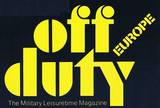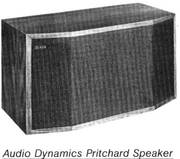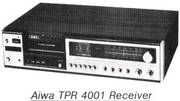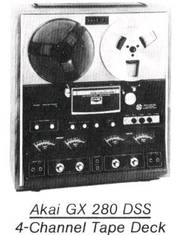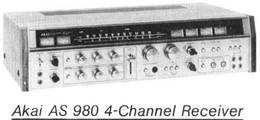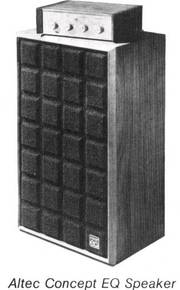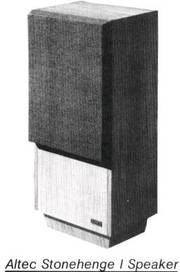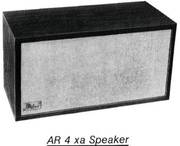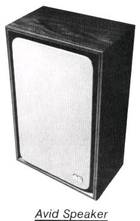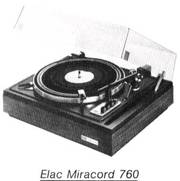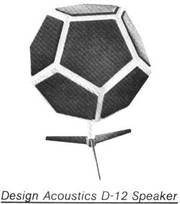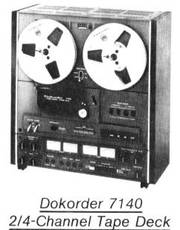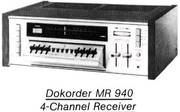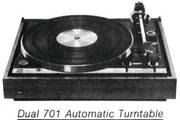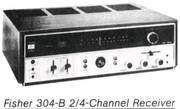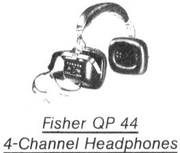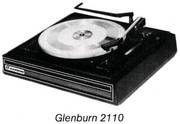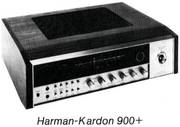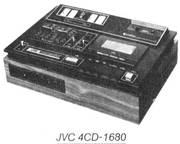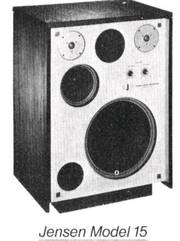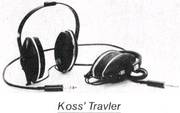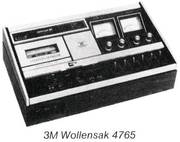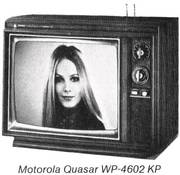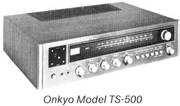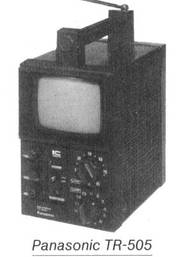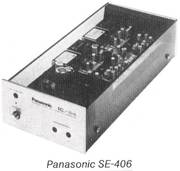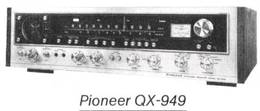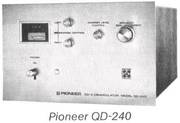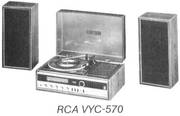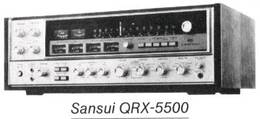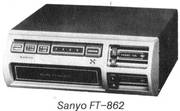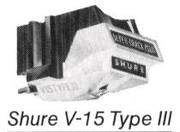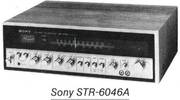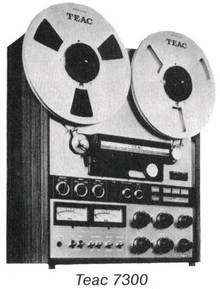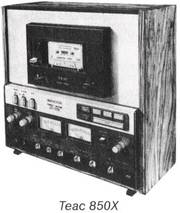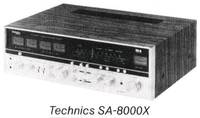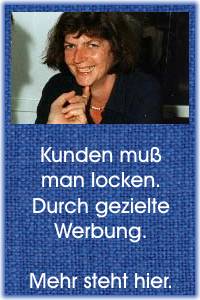"off duty" 1970 - 1997 - eine Freizeit-Zeitung für's US-Militär
Die in diesem amerikanischen (Freizeit-) Shopping-Magazin angepriesenen Hifi- und Video-Produkte waren auschließlich amerikanischen und kanadischen Militärangehörigen zugänglich - also zu kaufen - und vor allem zu ganz ungewöhnlich (verblüffend) niedrigen US $ Military-Preisen. Zu der einführenden "off duty" Seite geht es hier lang. - Um 1970 begann der weltweite Hifi-Boom bis zum 1. Crash 1978 und dann wieder zum 2.Crash um 1990. Über die 20 Jahre nach 2001 lesen Sie mehr auf dieser japanischen Seite.
Das ist die Folgeseite zu den Intros von W. Rios von der CES
Die Berichte und Kommentare von der CES Sommer 1973 sind auf 3 off-duty Magazine verteilt. Aus ganz einfachen logistischen Gründen habe ich die drei einführenden Artikel auf einer gemeinsamen Einführungsseite zusammengefaßt und hier aus den drei CES-Artikeln in den drei Heften die einzelnen Firmen und Geräte alphabetisch hintereinander aufgelistet.
.
Here's the first part of our stand-by-stand report from CES:
.
ADC (Audio Dynamics Corp.)
Cartridge maker ADC promises to have a new model ready for CD-4 records early this fall. Known as the Super XLM Quadraphonic Cartridge, it will retail in the States at $65.00. The XLM series, ADC's latest, is an induced magnet design offered with elliptical stylus for conventional stereo and matrixed four-channel records, priced Stateside at $50.00.
The same cartridge is offered at $40.00 in a somewhat less compliant version designed for more rugged use, known as the VLM. Both cartridges are guaranteed free of defect for ten years.
ADC also announced three new speaker systems including a multi-driver two-way design in an enclosure with slanted front panels to achieve 120 deg. dispersion of high frequencies. The woofer, mounted in the forward-facing center panel, is a high-compliance 12 in. cone, while each of the two side panels has a IV2 in. tweeter and 3/4 in. super-tweeter. The four tweeters, all of dome-type construction, handle frequencies above 600 Hz. A four-position contour control is provided on the front panel, beneath the removable grill.
Known as the Pritchard Loudspeaker System, it's ADC's top-of-the-line model (price not yet announced). There are also two new bookshelf models, the ADC-XT 10, a two-way system with 10 in. woofer and two 2Va in. tweeters, and the ADC-XT 6, a smaller two-way system with 6 in. woofer and one tweeter.
Admiral
With so much space available on the big cartons containing its TV sets, Admiral has put it to work to tell the story of its warranty "protection package." On an Admiral color TV, repairs are free the first year. In the second year, a defective picture will be replaced free. In the third year, the owner gets a 50 per cent discount on the cost of a rebuilt replacement tube. Discounts are 33 per cent the fourth year, 25 per cent the fifth year.
Admiral also features a toll-free "hot line" to call if your set needs repair, and promises to loan you a 12" color TV if your own set is out for repair more than two working days!
All of the latest Admiral color TV sets have one-button color control, the new circuit that automatically adjusts color, tint, brightness, contrast and AFC. There's also a new line of portable black-and-white sets, in 9" and 12" (diagonal) picture sizes, called the Travler series.
Like most of the majors, Admiral features four-channel sound in its top-of-the-line audio products. (Es sind aber nach wie vor Billig-Produkte). Latest is the STC-1511 compact system with four-channel eight-track cartridge tape player, stereo FM-AM radio and stereo record changer, all on one chassis, and four separate speakers.
An SQ matrix is built in for unscrambling matrixed records and FM stereocasts. A similar model, without the topside record player, is the STC-1501. Both also have jacks for stereo and four-channel headphones.
Advent
Appealing, as it does, to the audio cultist, the Advent line isn't displayed at McCormick Place during CES, but rather in a "North Michigan Avenue hotel", where visitors tiptoe into the demonstration room and listen attentively to a technical/sales presentation on the latest brainchild of innovator Henry Kloss.
Like its eccentric founder, the Advent company of Cambridge is not averse to leaping boldly in several directions at once. It usually lands on its feet, especially in the area of loudspeakers. This year's visitors saw and heard the prototype of a new model which, if its maker runs true to form, may be known as the Lower Cost Advent Speaker - Stateside price will be in the $55-60 range - or perhaps as the White Advent Speaker, since that is the only color offered.
The cabinet is a five-sided casting of plastic foam, poured into a white outer skin. An 8 in. woofer and two cone tweeters complete the system, which has a resonance of 58 Hz and high enough efficiency to make it suitable for use with 10 watt (rms) amplifiers. First deliveries are promised in August 1973.
Another current Advent project is the introduction of cassettes recorded with Dolby Noise Reduction circuitry on chromium dioxide (CrCO2) tape. So far, Advent has an offering of 20 titles drawn from the Connoisseur and Nonesuch record labels.
To play them, a cassette deck with both CrCO2 equalization and Dolby circuitry is required, so they are strictly for owners of the latest cassette equipment. Known as Advent Process CR/70 Cassettes, they are priced from $4.98 to $6.98, the latter promising a program length equivalent to a full-size LP disc. Details are available from Andrew Petite, Advent Corp., 195 Albany Street, Cambridge, MA 02139.
Most innovative of Henry Kloss' current projects is the Advent Videobeam Projection Color TV, a futuristic TV console that projects a color picture on a screen, eight feet away, that is more than ten times the size of a conventional 25" (diag.) TV screen. Sound, too, is beamed at the screen, though the Videobeam projector also has jacks for connecting the audio signal to a separate sound system. Designed to make TV viewing feasible in large rooms such as clubs and lounges, the Videobeam is now in production, with first models due for delivery this summer.
Though its products are familiar in PXs around the world, the Aiwa company's CES exhibit this year marks a "return" to U.S. shores after several years' absence. Since joining the Sony group a few years ago (Sony hatte die Aktien-Mehrheit gekauft), Aiwa's stock in trade has been the cassette, now built into almost every item in the line.
There is a new midget recorder, model TP-747, with all controls at the top edge of the case, a built-in electret condenser microphone, and automatic shut-off mechanism. Model TPR-501A is a recorder with AM-FM radio, while model TPR-220 boasts a third radio band (short wave), a two-way speaker with horn-type tweeter and a mixing control for recording.
On model TP-770, a portable recorder, an added feature is a pitch control system ranging from 20 per cent slowdown (for language study) to 50 per cent speedup for quick review and editing. The Aiwa Announce Machine, model AS-5, uses an endless loop cassette and has a built-in oscillator so the tape can be programmed to start and stop at desired points and repeat its message.
Top part of the Aiwa line includes a stereo cassette tape deck with Dolby and CrO2 bias/equalizer circuitry (model AD-1500) and two receivers: Model TPR-3010 has inputs for magnetic cartridge and jacks for adapting the set to four-channel, while its tape deck has CrO2 equalization and an instant-start mechanism for easy recording of all program material being played. Model TPR-4001 is a cartridge version offering full record/playback capability with 8-track tape cartridges, and a "memory" button to insure that only the desired channel is recorded or played back. Both receivers feature automatic shut-off and a sleep switch that shuts off all power at the end of the tape.
Open-reel tape is alive and well at Akai, still broadening its range of standard four-track, two-channel machines as well as the costlier four-channel variety. The 4440D is a new three-head stereo deck featuring selflubricating hysteresis motor, standard/low-noise tape selector switch, one-micron gap head, mixing and sound-on-sound; priced Stateside at $349.95.
The new quadraphonic model, GX-280DSS, has four separate heads, including two of the GX (glass and crystal ferrite) Type and solenoid-controlled three-motor drive. In addition to recording four discrete channels on the full width of the tape, it is bi-directional in conventional stereo with automatic reverse and continuous playback. Stateside retail price is $799.95.
There are two new cassette tape decks from Akai, both in the lower price range. Model CS-30D offers a one-micron gap head, induction motor, low-noise tape selector switch and a Stateside price of $159.95. The CS-33D, the same machine but with Dolby Noise Reduction circuitry as an additional feature, is priced at $199.95.
.
Dolby is also featured in the AA-910DB stereo receiver ($299.95), one of six models in Akai's growing line of receivers. Three of them are four-channel, the top model AS-980 (previewed in OFF DUTY April 73 issue) offering a built-in CD-4 demodulator with the all-important front/rear separation controls on the front panel.
For matrix four-channel it has both SQ logic and RM. Rated at 40 watts (rms) per channel, the AS-980 is priced Stateside at $799.95. The step-down four-channel models are the AS-970 (priced at $599.95) with 30 watts (rms) per channel and the AS-960 ($499.95) with 25 watts (rms) per channel. These models provide terminals for connecting CD-4 as an outboard accessory.
.
Altec
In a departure (Abflug) from its traditional "Voice of the Theater" designs for large halls and professional sound reinforcement, Altec has a new small speaker employing an equalizer to flatten the bass response of its sealed enclosure.
Called Concept EQ, it's a three-way design with 12 in. (77 sq. in.) bass driver, 13.3 sq. in. mid-range and dome tweeter. Extra damping of the woofer causes bass to roll off smoothly from 150 Hz down to 30 Hz. The active equalizer provides the reverse contour that straightens the response curve throughout the low frequency range.
In addition, the control console supplied with each pair of Concept EQ speakers, permits tailoring of mid-bass frequencies (centered around 80 Hz) to cancel unwanted effects caused by the listening room - standing waves, for example. The Concept EQ package (two speakers and electronic equalizer console) is priced Stateside at $475. Its components will also be available separately.
Another new product is the "Stonehenge I", a medium-efficiency speaker (25 watts rms minimum power required) in a tall, columnar enclosure finished on all four sides so it can be placed away from the wall if desired. Connecting terminals are in the base of the enclosure, which is of the reflex type. Inside is a woofer with 12 in. frame (82 sq. in. piston area) and a 3.3 sq. in. tweeter handling frequencies above 1800 Hz.
The dividing network, mounted on the front panel, has a continuously variable attenuator for adjustment of the highs. Because of its vertical design, the Stonehenge I requires only 1.4 sq. feet of floor space. Price per speaker will be somewhat less than $300, with first deliveries scheduled this fall.
Altec's Voice of the Theater components, a 15" (133 sq. in.) woofer and compression tweeter with sectoral horn, have a new dress called the Santiago, a low-boy enclosure with slate top and sculptured foam grill. There are two versions, one with conventional crossover network (model 878B), the other (model 2878B) with built-in two-channel amplifier and electronic crossover delivering 60 watts (rms) to the woofer and 30 watts (rms) to the tweeter.
Evidence of the growing importance of CES was the appearance this year of Acoustic Research, a long-time holdout against trade-only shows. Featured were two new loudspeaker models, an up-dated turntable and an aggressive new image.
Having recently moved from Cambridge to new facilities in Norwood, Mass., AR is expanding and, for the first time, actively courting hi-fi dealers around the countries for its broadening line of speakers.
Newest model is the AR-8, a two-way design with higher efficiency and greater power handling capacity, specifically to please the rock music crowd. With 10" woofer and 1 1/2"-tweeter, the AR-8 requires at least 15 watts (rms) of amplifier power and has a recommended Stateside price of $119.00. AR says its sound is brighter and harder than that of other AR speakers, but a three-position tweeter control trims the output to something more akin to the traditional AR sound.
The AR-4xa is a modification of the long-popular AR-4x. Enclosure and 8 in. woofer are unchanged, but the 1 1/2" cone tweeter and crossover network are new. The AR-4xa requires at least 15 watts (rms) of amplifier power. Suggested Stateside price of the two-way, 8 ohm system is $75.00.
Another sure sign that Acoustic Research has shed its ultra-conservative cloak: the AR turntable now has a viscous-damped cue/pause control. It's now known as the AR-XB.
Audio Project
In a variation on the successful nine-speaker configuration utilizing mostly reflected sound, this new Washington, D.C. manufacturer offers its Model Five in a similar cabinet - eight speakers on rear panels angled toward the wall and the ninth speaker in front. Audio Project, however, adds a piezoelectric tweeter in front. Also, its nine woofers are actually twin-cone full-range drivers. An active equalizer is employed for bass frequencies only.
The Audio Project tweeter, a ceramic transducer that works on the same principle as a crystal phonograph cartridge, has no magnet or voice coil and requires no crossover network. It's featured also in the firm's new Model 7, a straight bookshelf design pairing the tweeter with a 10" woofer, and in the Model 6, in which the tweeter is mounted in the rear. Still another version, Model 10, has angled side panels for the tweeters (five in all) to widen the system's angle of dispersion. Details are available from Audio Project, 3310 New York Ave., N.E., Washington, D.C. 20002.
Audiovox
Specializing in car stereo. - entfällt -
.
Autoquad
While full-blown discrete four-channel makes strong gains and matrix systems get ever more sophisticated in their circuitry, the simplest type of matrix decoder is still around to tempt those who want to sample hemidemi-quadrophonics at minimum cost. Built on a principle espoused by engineer David Hafler, it is a method of wiring four speakers to the terminals of a conventional stereo amplifier, and separating (by plus-and-minus matrixing) the out-of-phase, rear-channel signals.
Autoquad is the latest firm to offer an adapter for the purpose, a simple "black box" known as a Passive Matrix Decoder. Details are available from The Autoquad Co., P.O. Box 18044, Dallas, TX 75218.
Avid
Here's another new name in loudspeakers, featuring colorful pre-shaped fabric grills, easily changed to suit the decor.
Called the "Series 100," the Avid line of speakers consists of
Model 103, a three-way system priced Stateside at $139.50;
Model 102, a two-way system ($109.50); and
Model 100, a two-way bookshelf system ($79.50).
Details are available from Avid Corp., 10 Tripps Lane, East Providence, R.I. 02914.
BASF
First manufacturer to "key" a cassette machine for chromium dioxide tape is, appropriately enough, the German company that started the magnetic tape business to begin with, BASF. Its new series of recorders with automatic CrCO2 switching is very likely the forerunner of many such models scheduled for European introduction at the mammoth "International Radio Fair" in West Berlin, Aug. 31 - Sept. 9.1973. There are four BASF models, ranging from a standard portable (9101), full-size portable (9201) and radio-recorder (9301), to a tape deck (8100 CrO2) meeting Germany's DIN 45,500 specifications for high fidelity equipment. The deck also features a noise reduction circuit known as DNL (Dynamic Noise Limiter) which differs from Dolby in that it works only in playback. It also has an automatic recording-level control that, like the DNL circuit, can be switched out if desired.
BASF's tape cassettes offer, as a patented extra feature, a "Special Mechanics" construction consisting of two plastic tape guides that provide internal braking of the tape motion and, according to BASF, make the cassettes jamproof. The feature is built into the new, keyed Chromdioxid cassettes, as well as BASF's Low-Noise/High-Output cassettes and standard SK series.
Benjamin / ELAC
Germany's Elac, imported Stateside by Benjamin Electronic Sound Co. of Farmingdale, N.Y., introduced the Miracord 760 automatic turntable at CES. It's almost identical to Elac's deluxe model, the Miracord 50H Mk II, except for the motor, which is of the four-pole induction type instead of the costlier hysteresis synchronous design used in the 50H.
The tone arm is dynamically balanced in all planes, making it suitable for use with the most sensitive cartridges tracking at less than one gram. Cueing is by means of a silicon-controlled piston. A long spindle is provided for automatic changer operation if desired.
It's not official yet, but Elac will go the CD-4 route later this year. A new cartridge for discrete four-channel records will probably be ready for introduction by the time of the Berlin show.
Another Benjamin import, Switzerland's Lenco, has a new deluxe single-play turntable with automatic arm-lift and shut-off at the end of the disc. The L85 features belt drive, and electronic fine speed control checked by means of an illuminated strobe. Unlike Lenco's other models which feature continuously variable speeds from 30 to 86 rpm, this one employs a 16-pole synchronous motor and offers only the two standard speeds with adjustment to ±3 per cent.
Benjamin's Concord Division, which imports Japanese-made receivers for sale under its own name, has a new four-channel model, CR-400, with SQ decoder plus a "synthetic" quadraphonic circuit for playing stereo records through all four channels. There are jacks for connecting CD-4 and four-channel FM adapters when required. Power rating of the Concord CR-400 is 12.5 watts (rms) per channel.
.
It figured that Bose, whose 901 speaker systems are notoriously power-hungry, might join the ranks of electronics manufacturers turning out super-amplifiers to meet this need.
Now that the 1801 power amp is available, Bose has also devised a unique way of promoting it - with a headphone demonstration comparing the simon-pure signal that goes into the amplifier with the super-amplified signal that goes out to the speakers.
Visitors to the Bose suite at Chicago's Palmer House Hotel during CES were dared to detect the difference. I tried it and couldn't. The 1801 rates, as you might expect from its $1,000 U.S. price tag, as a superb 500-watts-(rms)- per-channel-with-both-channels-driven stereo amplifier. As an extra, you get an LED (light emitting diode) display on the front panel that tells you instantaneously how much amplifier power is being used and, according to Bose, will detect amplifier clipping more accurately than standard VU meters.
The 901 has been slightly modified. Latest models contain speakers (nine to a box) with somewhat more high-end response, and the matching equalizer supplied with each pair has an additional click-stop on the high-frequency control. The sound is unchanged, but Bose says that the additional treble energy makes speaker placement less critical since there is now more leeway in distance from the reflecting walls and sound-absorbing characteristics of the wall surfaces.
Bose also has several lines of conventional direct-radiating speakers to offer dealers handling the 901 and 501 direct/reflecting variety. Known variously as Interaudio, Studiocraft, and Sonic Art - so that each Bose dealer can carry an "exclusive" private-label line - they are offered with a full-purchase-price trade-in value if the customer goes back to the store and "trades up" to the costlier 901.
.
Now that Audio Devices, one of the oldest manufacturers of magnetic recording tape, is part of Hollywood's "Capitol Records" group, it's rapidly shedding its staid old-time look and moving with the mod crowd.
A new "Mod Line" of blank tapes from Capitol has the advertising on the film wrapping and a colorful box underneath. The idea, says Capitol's promotion department, is to make tape boxes look as appealing as record jackets.
On the engineering side, Capitol boasts a new 100-minute cartridge. Developed for the 8-track cartridge version of a special Beatles album, the exta-length cartridge is now
available in a blank-tape version as well (so you can dub your own, one might add).
Capitol's cassette tapes are now sold in twin-cassette boxes called Stak-Paks that snap or slide together to form a chest of drawers. The standard line, called "Capitol 2", offers both high-output/low-noise oxide and general-purpose oxide in open-reel and a lubricated tape in "Audiopak" 8-track cartridges, plus cassette Stak-Paks in C-40, C-60, C-90 and C-120 lengths. The Capitol 2 line will soon be available at exchange tape counters around the world.
Design Acoustics
The need for wide dispersion of high frequencies has bred still another unusual speaker design. Design Acoustics' D-12, in a 12-sided enclosure mounted on a steel pedestal, packs a downward-facing 10" woofer, upward-facing 5" midrange driver and nine 2 1/2 in. cone tweeters facing in all directions to radiate sound 360 degrees. The twelfth facet of the polyhedral speaker is a port for the woofer, tuned to a frequency of 27 Hz. The D-12 is available in a variety of colors, Stateside prices ranging from $349.00 to $375.00.
Design Acoustics' second model, the D-6, has more conventional styling - i.e. it looks like a box - but the configuration of the five 2 1/2" tweeters under the protruding front grill is such as to strive for 180-deg. dispersion in vertical and horizontal planes. The 5" midrange driver faces forward and the 10 in. woofer faces to the rear, requiring that the speaker be placed several inches from the rear wall. Details are available from Design Acoustics, P.O. Box 2722, Palos Verdes, CA 90274.
.
Dimension Design
Another polyhedral speaker unit comes from Dimension. There are 14 sides on this one, but there are speakers on only three facets - two 8" dual cones and one tweeter. The cabinet is cast polyethylene and guaranteed not to crack or split under normal use, which includes sitting, eating, drinking and washing. It is mounted on ball-type casters and comes in a variety of colors, priced Stateside at $129.95. Maker is Van Buren Industries, 1025 Ashworth Rd., West Des Moines, Iowa 50265.
Dokorder
The first four-channel tape deck from Dokorder, model 7140, features the Multi-Sync function that permits recording or re-recording one or more tracks in synch with tracks previously recorded.
The synchronization is accomplished by switching selected tracks on the recording head into the playback mode so the previously recorded signals being monitored will be heard together with new tracks being recorded. For normal playback, and for monitoring new tracks during recording, the 7140 has a separate playback head.
Mechanically, the new Dokorder offers three motors including capstan motor of the synchronous type, with all tape motion controlled by pushbutton solenoids. Sound-on-sound and electronic echo are among the built-in conveniences, and a bias switch is provided for normal or low-noise/high-output tape.
Another new tape deck, model 7100, is mechanically the same but with conventional stereo electronics. Docorder's tape heads, however, are of the plug-in type, and this permits a four-gap playback head to be added optionally, for playback of prerecorded four-channel tapes.
Two new Dokorder receivers, one four-channel and the other conventional stereo, feature the "kangaroo pouch" console for seldom used controls that distinguishes Dokorder's earlier receiver models. The MR-940 is rated at 30 watts (rms) per channel in quadraphonic operation. Its BTL circuit straps front and rear channels, if desired, to put out 58 watts per channel (at 8 ohms) in stereo mode. Model MR-900, stereo only, is rated at 100 watts (rms) per channel at 8 ohms with both channels driven.
Dual
With continual refinements in high-performance cartridges making collectors fussier than ever about their records, it had to happen: Dual's new top-of-the-line automatic turntable doesn't have a long spindle (die Wechsler Achse) at all. It holds strictly one disc at a time.
The 701 features an all-electronic direct-drive DC motor, with the platter driven directly by the rotor. The two speeds are regulated electronically - no belts or pulleys or friction-idlers needed - with integrated circuits, Hall-effect generators and two layers of coils (16 in all) achieving a gapless, rotating magnetic field that Dual says is pulse-free.
The tone arm features two separate mechanically filters, built into the counter-balance, for isolation from acoustical feedback. And there arc the usual fancy-turntable extras, of course - illuminated strobe and pitch control (8% for each speed), anti-skating, silicon-damped cueing lever - to go with the cool Stateside retail price of $350.00.
Dual's regular line of automatics has a new medium-price entry, the 1216, with a 4 lb. platter and the same anti-skating system offered in the higher-priced Duals. Stateside price is $139.50.
Dyna
Sticking to a policy of planned non-ob-solesence, Dyna announces that it has improved its Stereo 120 amplifier by changing a couple of the transistors to new, more rugged designs that make the circuitry more reliable under adverse load conditions. Owners of the 120 will get the modification as a matter of course if their amplifier requires service. If the unit is operating properly but the owner wants the circuitry update anyway, there is a nominal charge. Ask for the "Stereo 120 TIP Modification."
With jumbo power amplifiers proliferating, Dyna noticed that most of them sport big meters on the front. So Dyna's own jumbo, model 400, is now available with a pair of meters. But the frill adds $75.00 to the price, now $524.00 for the Stereo 400 kit.
Three new receivers from Fisher all feature a strapped output that makes them equally at home in stereo or quadraphonic operation. Models 4020 and 4060, both in the medium-price range, are rated respectively at 10 and 15 watts (rms) per channel at 8 ohms, measured at 1 kHz with all four channels driven. Strapped for stereo, power capability rises to 22 watts per channel for the 4020 and 36 watts per channel for the 4060 with both channels driven.
The third model, 304-B, is a new entry in Fisher's fancier Studio Standard line of components. Priced Stateside at $399.95, its 8 ohm power rating is 15 watts (rms) per channel, measured throughout the 20-20,000 Hz bandwidth with all four channels driven. Total harmonic distortion at rated power is 0.5 per cent, IM distortion 0.8 per cent. Strapped for stereo, the 304-B delivers 30 watts (rms) per channel under the same conditions. This model also has slide-type tone and level controls and "joystick" master balance control. All three new four-channel receivers provide SQ matrix decoders and terminals for adding an outboard CD-4 demodulator.
The sculptured foam grill is increasingly evident in Fisher's speakers. There are three new models: ST-425 two-way system with 10 in. woofer and dome tweeter; ST-445 three-way system with 10" woofer, 4 1/2" cone midrange and dome tweeter; and ST-465 three-way system with 12 in. woofer, dome tweeter and a new flare-dome mid-range driver.
The fanciest of the three, model ST-465, requires at least 25 watts (rms) of amplifier power. Finished in walnut veneer, its Stateside price is $169.95. The ST-425 and ST-445, in walnut vinyl finish, are $79.95 and $99.95 respectively.
Fisher has a new headphone wired for four-channel as well as stereo, selected at the flick of a switch on the left earcup. It's model QP-44, Stateside priced at $69.95.
General Electric
A new portable radio by G.E. has a feature that many high fidelity fans wish was built into stereo receivers: TV sound. Besides AM and FM, an extra band is provided with the audio portion of VHF channels 2-13. The portable plays on 110 AC or four AA batteries. Suggested retail price Stateside is $42.95.
Another G.E. portable, model M 8617, is an interlocking two-piece unit combining an 8-track stereo, tape cartridge player with FM/AM stereo radio. Each half contains a 4 in. speaker, and the set plays in both open and closed position, powered by AC, a set of eight D batteries, or an auto/boat cigarette lighter with the adapter provided. Stateside price is $104.95.
G.E.'s plunge into four-channel includes not only the typical package system consisting of moderate-power receiver with built-in four-channel tape cartridge player and four speakers (model SC 4205, $339.95), but a stereo receiver that can be adapted to quadraphonics by means of outboard accessories and additional speakers (G.E. calls it a "QuadraFi" sound system). Basic unit is the RA 200 stereo receiver, rated at 10 watts (rms) per channel at 8 ohms with one per cent THD. Terminals and front-panel switching for up to four speaker combinations are provided. Stateside price of the receiver is $189.95.
Continued next month.
.
Here's the second part of our stand-by-stand report from CES:
.
Glenburn
Along with a new line of moderate-price automatic turntables, the Glenburn / McDonald company announces it will soon offer a turntable with ceramic cartridge for CD-4 quadraphonic records. The ceramic design much cheaper than the magnetic type of pickup favored in the high fidelity field, helps put discrete 4-channel records into the popular-price market.
The new model, promised for late this year, is the Glenburn AT110, featuring a ball-race pivot in the tone arm to achieve the low tracking force required for playing the new discs. It will be supplied complete with cartridge and CD-4 demodulator.
Glenburn/McDonald's regular line consists of the 2110 automatic turntable module complete with base, dust cover and Shure M75 cartridge, priced Stateside at $74 and model 1100 with ceramic cartridge priced at $49.95. The latter model is also available without base and dust cover, as a replacement record changer, for $34.50. Completing the line is the Glenburn SP-10 playback deck for 8-track cartridge tapes, priced at $49.95.
The McDonald in the company name, incidentally, is the same chap who developed the BSR turntables. His new place of business is Glenburn/McDonald, Inc., 787 Susquehanna Ave., Franklin Lakes, NJ 07417.
Harman-Kardon
When Harman-Kardon's Multichannel series of receivers was first shown at CES in 1972, its dominant feature was a "phase inversion" type of bridging circuit to permit strapping the four amplifiers into a pair for conventional stereo.
Now there are three more Multichannel receivers from H-K, and two of them still have the bridging feature (a slide switch on the rear panel). But the feature is no longer dominant, since the new 700+, 800+ and 900+ all have built-in CD-4 demodulators and thus reflect the market's much firmer commitment to 4-channel.
They also have a two-position SQ matrix (the second position more akin to the QS "regular matrix") and an "enhanced stereo" position for playing stereo recordings through all four amplifiers. Pretty unlikely, then, that the owner will be strapping the amplifiers for stereo, unless he happens to be short two loudspeakers.
All three new receivers employ the "joystick" type of 360-degree balance control. All are rated conservatively with continous power measured at 0.5 per cent THD throughout the 20-20,000 Hz bandwidth with all four channels driven. The 700 + offers 18 watts per channel, model 800 + 22 watts per channel and the top-of-the-line 900+ 32 watts per channel.
The 900+ also has the best tuner specifications in the series and features extra circuits such as a quieting meter that reads signal-to-noise ratio (instead of only signal strength) in order to tune for minimum distortion. There are extra switches, too, on the 900+, to provide individual control of front and rear speakers in both main and remote 4-channel systems, or eight loudspeakers in all.
Hear Muffs
Styled like a giant doughnut with a bite missing, the Hear Muff is a headphone built into a cushion that wraps around the back of the head.
The speaker elements are imbedded in molded foam. Steel bands within the foam can be adjusted from the outside to shape the cushion to the head. The covering is washable velour fabric available in a variety of colors and patterns. Stateside prices of Hear Muffs range from $29.95 to $99.95, with models available in both stereo and 4-channel. The quadraphonic version called the Model QM-440 Quadramuff, contains four separate 3V2-in. drivers and features a separation-enhancing phase control.
Its Stateside retail price is $49.95. Another model, QM-442, will include a passive matrix decoder/synthesizer called Quadserch for use with any stereo amplifier or receiver, with no additional decoder necessary. Higher-priced Quadramuffs with advanced high velocity drivers and controls for both internal and external matrix decoders as well as discrete 4-channel listening are promised for later in the year. The matrix in the Quadramuff is known as the Fixler circuit, after its designer, John Fixler, who together with engineer Leonard Feldman devised the quadraphonic matrix system introduced by Electro-Voice. Hear Muffs also announces that it will manufacture Fixler-type quadraphonic headphones in conventional styling for distribution under other brand names.
Hegeman
The audio cultists at CES who usually find engineer Stu Hegeman holding forth in a nearby hotel suite were surprised this year to find Hegeman Laboratories as a full-fledged exhibitor at McCormick Place. Featured was the Hegeman 1 loudspeaker, an omnidirectional 2-way system housed in a floor-standing sealed-box cabinet with drivers mounted on a tilted plane.
This bounces the sound against the wall at an angle that projects it out into the room. The system's 8" woofer with a dispersing cone deflector and domed super-tweeter (crossing over at 5,000 Hz) are coaxially mounted on top of the enclosure, just over 2 ft. tall. Finished in teak with a charcoal grill, the Hegeman 1 has a Stateside price of $114. Details are available from Hegeman Laboratories, Inc., 176 Linden Ave., Glen Ridge, NJ 07028.
Infinity
This is a speaker line for people with a lot of bread - a cool $2,100 Stateside for the Servo-Statik 1 system, for example (ANmerkung : anfänglich sogar nur 1.700.- Dollar) - but for the people who want to get as near as possible to the Servo-Statik sound without going broke, Infinity has a new speaker called the Monitor which they say is the next best thing to the Servo Statik.
The Infinity Monitor features a new "wave transmission-line" tweeter which lias a frequency response up to 38kHz and a 360-degree dispersion pattern. This tweeter is a complicated device developed by Ohm Acoustics and Infinity claims that it is a "perfectly coherent radiating source".
In addition to the new-type tweeter, the Monitor speaker has a standard midrange transducer and an extra-heavy woofer with a maximum power rating of 200 watts rms.
Because of Infinity's reputation, the initial production run of the new speaker was sold out immediately (priced stateside at $429 each) but we were told that a dozen of the new models were reserved for the European military distributor (das war damals Audio Intl. in Frankfurt Bonames), so you may see a few Monitors in the clubs before long. Infinity also announced that it will no longer produce the Holosonic model but that it is developing a new model which will be in the same price range of the Holosonic.
JVC-Nivico
Maybe you have wondered why there are no 4-channel cassette recorders. Wonder no longer. They're on the way. What held up 4-channel action in cassettes is Philips' insistence that it be compatible with stereo and mono cassettes - and, since the Dutch company owns the patent rights, designers had to go along.
Anmerkung :Unter Unterminierung des Grundig DC100 Kassetten Konzeptes hatten die Philips "Beauftagen" die Einscheidung für Grundig ausgetrickst und die weltweite Lizenz für die CC-Kassette kostenlos angeboten. Doch die Rrestriiktion, daß das Grundkontept immer und überall kompatibel sein mußte, hatten auch die Japaner unterschrieben.
Now they've come up with a new cassette head that JVC calls "Cronios." It's made to close enough tolerance to pick up eight separate signals on the standard 0.15 in. wide cassette tape.
That means four discrete channels in each direction, double the number of tracks recorded on stereo cassettes. What makes it compatible is that the tracks are side by side.
Play a stereo tape on a 4-channel machine and the new head automatically picks up the same signal for the front and rear channels. Or play a 4-channel tape on your portable mono cassette machine and the wider mono head picks up all four signals simultaneously so you hear all the music (though in mono, of course).
JVC's newly announced 4CD-1680 cassette deck also has a noise-reduction system, but it's the company's own ANRS instead of the nearly universal (and costlier) Dolby. Another JVC circuit on the deck employs phase shift and feedback to reduce crosstalk.
Amplification circuitry, too, has been modified to achieve the better signal-to-noise characteristics needed to handle the narrower track width on 4-channel tapes. Bias and equalization circuitry is provided for normal, low-noise and chromium dioxide tapes.
Elsewhere on the 4-channel scene, JVC's total commitment to CD-4 is understandable (they invented it) but the company's new line of receivers with built-in demodulators is just starting to appear.
First to get supplies will probably be Pacific exchanges, with Stateside retailers and European PXs and clubs getting theirs as fast as production of new compact CD-4 demodulator modules catches up.
The 4VR-5406, with the all-black styling of most JVC receivers, is the first of this series with built-in CD-4. A differently-styled 4-channel series is also planned, its model designations 4VR-5456, 4VR-5456, 4VR-5446 and 4VR-5436, all with CD-4 circuitry.
Janszen
Though Janszen has turned out electrostatic tweeters and hybrid speaker systems (with dynamic woofers) for over 20 years, this year's CES offered the first look at a Janszen electrostatic headphone. And it's the largest and costliest yet ($300) consisting of two Janszen electrostatic elements mounted on a bulky but lightweight hood that fits over the head and looks right out of a science-fiction TV series.
Most Janszen loudspeakers employ four of the same electrostatic elements, mounted at slight angles for greater high frequency dispersion, in a cabinet with dynamic woofer. A new top-of-the-line model, Z824, is a slanted-front console with eight elements and two 12-in. woofers, bearing a $495 price tag. The lowest-price Janszen is the Z210a, with two elements and 10-in. woofer, at $109.95. A variety of grills in etched foam is offered. Military discount prices for Janszen are available by mail from Delrama International, 37 Newton Road, Plainview, NY 11803.
JBL
The newest speaker system from JBL is one of the California firm's lowest priced models - $129 Stateside - and also modest in size. It has a 10-in. woofer and 1.4-in. tweeter. The enclosure is ported, giving it the high efficiency that makes it suitable for use with low-powered amplifiers. The new JBL is called the L26 Decade. The cabinet has a light oak finish and a choice of four grills is offered: orange, blue, white or brown.
Jensen
Most new speakers from this Chicago-land manufacturer are designed for outdoor use - in boats, trailers, motor homes as well as cars. Latest in the "Mobile High Fidelity" series is a coaxial system combining 6x9-in. oval woofer and 3-in. tweeter, each with its own magnet.
It's available in a kit (No. C9740) that includes two speakers, two grills, cable and mounting hardware. There is also a rear deck model (C9739) with front/rear fader control, and Jensen offers any of the mobile speakers singly for use as replacements in upgrading a car stereo installation.
Also mobile, in a way, is Jensen's latest speaker system for the home - because its cabinet is finished on all sides (including the back) and can be moved out from the wall to the center of the room if desired. The Model 15 is a 4-way, 5-speaker system with 15-in. woofer, 8-in. midrange driver, 5-in. tweeter and two dome-type ultra-tweeters. Loading of the bass unit is by means of a tuned port, so it can be driven with as little as ten watts of amplifier power. Stateside retail price is $396.
Details on Jensen speakers are available from J. D. Marshall International, P. O. Box 59466, Chicago, II. 60606
The resemblance in name between Kensonic and Kenwood is not so coincidental, because its founders, the Kasuga brothers, were also founders of Trio-Kenwood a few years back.
Their new company has a line of Cadillac-class components called Accuphase with specifications out of sight ... and so are the prices. Due this fall are a $750 power amplifier, a $600 pre amp and a $650 tuner - and never mind 4-channel, these Stateside prices are for a stereo system.
By mid-1974 Kensonic will offer integrated amplifiers and, perhaps late next year, the first Accuphase receiver.
For the hefty bread you get, in the P-300 power amp, 150 watts (rms) per channel at 8 ohms, rated with both channels operating simultaneously and distortion never exceeding 0.1 per cent at any frequency from 20 to 20,000 Hz. The C-200 control unit and C-100 tuner both have a sub-panel on the front, covered when not in use, that permits extra equipment and test gear to be connected without disturbing rear-panel connections.
On the tuner, the sub-panel includes a third meter to measure multi-path distortion. The preamp's extras include a copy switch for dubbing from the tape monitor circuit to other tape recorders, and there are switches galore for multiple speakers, extra tape equipment and for adding 4-channel capability.
The Kensonic line will be available at military discount prices but distribution will be limited. For details on where to get it, write "Kensonic" on the reader information card in this issue of Off Duty.
Kenwood
While stereo is still very much around at Kenwood, the new action is in 4-channel components. The latest top-of-the-line receiver, model KR-9340, has everything built in, including CD-4, SQ and QS (Regular Matrix).
Then there are three "step-down" models with fewer features but provisions for upgrading them as the budget permits. For example, the KR-8340 and KR-6340 receivers, which don't include CD-4, have a slot on the rear panel for a plug-in CD-4 module available as an accessory.
On the KR-5340, the smallest 4-channel model, there is no slot but CD-4 can be connected as an outboard accessory. These models also have a strappable output, which Kenwood calls "Two-Four," that offers a choice of stereo or 4-channel operation at the flick of a front-panel switch.
In stereo the front and rear amplifier channels arc combined for more than double the wattage. Power ratings, with all channels operating simultaneously into an 8-ohm lead, start at 10 watts (rms) per channel for the KR-5340 (at 0.8 per cent distortion throughout the 20-20,000 Hz bandwidth).
Switched to stereo, the same model offers 25 watts per channel at the same rating. The KR-6340 and KR-8340, rated the same way, offer 17 watts and 25 watts per channel respectively in 4-channel mode, 40 watts and 70 watts per channel in stereo.
And the KR-9340, strictly 4-channel, moves up to 45 watts per channel with an even more conservative distortion rating of 0.5 per cent at rated output. This top-price model also has four separate VU meters, terminals for two 4-channel-type systems and provisions for tape dubbing.
Kenwood's new loudspeakers feature mod styling of the grill, available in red and blue. They are models KL-33, KL-44 and KL-55, all two-way systems, and a 3-way system in air-suspension enclosure with 12-in. woofer, model KL-77. Also new is the KP-5022 turntable, a direct-drive model for single play, but featuring automatic repeat and automatic arm return as well as no-hand cueing of the disc.
To tease visiting dealers at their CES stand, the Kenwood people also presented their own mod version of today's super-powered amplifier - unlike most others, designed for 4-channel.
Rated at 500 watts (rms) per channel, the A2000X and its special preamp, the P2000X, may be the jumbo-est jumbo of them all. It has knobs the size of hubcaps and weighs a mere 287 lbs. Price was not announced.
Koss
A pocket-size headphone is the newest item from Koss Corporation of Milwaukee'. It has a telescoping headband that allows the two earcups to be scrunched together into a convenient package for traveling. Opened up, it's a full-size dynamic phone with lV2-in. Mylar driver elements arid PVC foam cushions. A traveling pouch is provided for the new model, known as the Koss Travler. Stateside price $22.95.
Lear Jet (the 8-track cartridge founder)
Known mostly for the 8-track cartridge that put car stereo on the road, the Lear Jet people are branching out. Now they offer three models for the home, all with Stereo 8 cartridge tape player, stereo radio and two separate speakers.
The deluxe Model H-450 is a cartridge recorder as well as a playback unit. Model H-440 is a typical "compact" with top-mounted record changer, while Model H-430 sheds the record player and comes in at a lower price.
There are two new Stereo 8 models for installation in car, boat or trailer. Model A-145 includes a stereo FM car radio, while Model A-20 is an economy model priced Stateside at $29.88.
But Lear Jet's biggest surprise is, would you believe, a pair of cassette models for the car. Not that the Tucson, Ariz., firm is backing off from its very own and very successful cartridge system. It's just that some people already have cassettes and want to play them in the car, and Lear Jet wants their business, too. Both the Lear Jet A-52 and A-152 auto cassette player feature automatic reverse, the latter model also having a built-in FM-stereo tuner.
And, now that Lear Jet has both cartridge and cassette, it's embarking on a non-partisan campaign to promote car stereo. Its new booklet, "How to Buy Stereo for Your Car", doesn't even mention Lear Jet except for a tiny address on the last page. Available from Lear Jet Stereo, Inc., 6868 S. Plumer Ave., Tucson, AZ 85706.
Continued next month.
.
Here's the third part of our stand-by-stand report from CES:
.
3M -Wollensak
To hold its own against a horde of popular-price imports a U.S.-made tape recorder has to have a lot of chutzpah or maybe something special in the way of features.
The 3M Company's Minicom Division, equipment producing arm of the giant tape maker, apparently offers the latter, because its new cassette tape deck is currently the darling of Stateside tape snobs. Outwardly it's not much different from the current crop of top quality decks with Dolby noise reduction circuitry.
What sets it apart is the tape transport mechanism inside, a pick-up from 3M's instrumentation equipment which is "over-designed" compared to most consumer products and thus, according to 3M, more reliable than the others.
The Minicom people call the mechanism "Dual Direct Drive" and point out that theirs is a beltless system. Wow and flutter are rated at less than 0.15 per cent. It has automatic shut-off at the end of the tape in recording and playback, and a "Guardian" mechanism that disengages the pinch roller and shuts off in the event of stalling due to a defective cassette.
On the electronics side, the Wollensak machine (Model 4765) has two pairs of Dolby calibration controls, one each for standard and chromium dioxide tape formulas. The Dolby circuitry also has an FM switch for use on Dolbyzed brondcasts.
For details, write "Wollensak" on the Reader Information Card in this issue of OFF DUTY.
Magnetic video
A new method of "speed listening" is featured in an unusual cassette tape recorder introduced by Magnetic Video Corporation. With a new integrated circuit module called VSC (Variable Speed Control), the mechanism compresses speech up to 2 1/2 times normal speed without changing the pitch - that is, the sound is not accelerated (as in, say, a 3 3/4 ips tape played at 7 1/2 ips) which would produce a sound a la Donald Duck.
Instead, VSC lops off redundant sound waves while playing the tape at higher speed, decelerating the remaining sound waves so the pitch you hear is nearly normal. A compressed tape made on a machine equipped with VSC can be played on any conventional tape machine.
Magnetic Video offers VSC in a special Copycorder that combines two cassette mechanisms in a single unit. One side of the Copycorder is a conventional cassette recorder, while the other half is specifically for making dubbings, which can be compressed to whatever degree of VSC is desired.
The manufacturer claims that compressed tapes made with the Copycorder (Model CC-103) permit speed listening of 250-300 words per minute. Stateside list price of the Copycorder is 8495. There are also two lower priced models without the VSC feature. Details are available from Magnetic Video Corporation, 23434 Industrial Park Court, Farmington, Mich. 48024.
Marantz
Of five new 4-channel receivers introduced by Marantz, four offer built-in Dolby noise reduction circuitry. On these new receivers, the signal strength meter doubles as Dolby level meter when calibrating the circuitry for tape (with the 400 Hz oscillator built into the receiver) or for Dolby-ized FM broadcasts.
There is a new 5-position Dolby selector on the front panel, for switching noise reduction into either of two tape recording circuits, the tape playback circuit, the FM circuit, or shutting it off.
That's the setup on the new Marantz 4300, new top-of-the-line "Quadradial" model. Like earlier Quadradial models from Marantz, it has a special socket on the underside for an optional SQ decoder or other matrix device so the user can update the decoder as new, more sophisticated logic circuitry is introduced.
- Anmerkung : Laut Schaltplan war dieser Unterseiten-Slot auch in dem späteren 4400 Topmodell nie für CD-4 konzipiert/geeignet.
Rear-panel connections are provided for quadraphonic FM and CD-4 demodulator circuitry as outboard accessories. Remote control of 4-channel balance is another optional extra on the 4300, which is rated at 40 watts (rms) per channel. In stereo, a bridging circuit
increases power output to 100 watts per channel. Stateside price of the Marantz 4300 is $899.95.
Next lower priced model is 4270 with 25 watts (rms) per channel (or 70 watts per channel in stereo), rated with THD of 0.3 per cent from 20 to 20,000 Hz and priced at $699.95.
Model 4240, at $549.95, offers 17 watts (rms) per channel at 0.5 per cent THD, or 40 watts per channel in stereo. All three, incidentally, have a built-in decoder called Vari-Matrix that synthesizes a rear-channel signal from conventional stereo records and plays matrixed material, in addition to having a pocket for an optional decoder. So does the still lower-priced model 4230, with 12 watts (rms) per channel (30 watts per channel in stereo), at 8449.95.
But the budget model, 4220, sheds the pocket as well as the Dolby circuitry, to duck below the $300 price level. It has built-in SQ, and a power rating of 8 watts (rms) per channel or 20 watts per channel in stereo.
Marantz also has a new 4-channel amplifier, model 4140, with 25 watts (rms) per channel or 70 watts per channel in stereo. This, too, has the decoder pocket and built-in Vari-Matrix, and carries a $549.95 price tag.
And, for converting a stereo system to 4-channel operation, Marantz offers the Model 4000 Quadradial Adapter with decoder circuitry a rear channel amplifier, and master controls for all four channels, priced at $249.95.
There is also a lower-cost Quadradial amplifier, Model 4070, offering 15 watts (rms) per channel at 0.5 per cent THD from 40 to 20,000 Hz, or 35 watts per channel in stereo. Its Stateside price is $299.95.
Latest Marantz tuner is Model 115B, priced at $279.95. It has a rear-panel jack for connecting the necessary decoder for 4-channel broadcasting later on.
There are two new floor-standing speaker systems from Marantz as well. The Imperial 9 has 10-in. woofers, four mid-range drivers and three tweeters, while the smaller Imperial 8 has a single 12-in. woofer, three-mid-range speakers and two tweeters. The array of transducers, says Marantz, can be rotated in order to produce an exactly symmetrical mirror image from a pair of speakers, for more precise dispersion and stereo separation.
.
McAdam Instruments
Two years ago at CES we reported on the McAdam Tester, a unique combination of test gear on a single chassis that measure frequency response, power output, harmonic and IM distortion.
Costing a cool couple of thousand, it's not for everybody but a useful instrument for clubs and hobby shops as well as audio dealers who like to check out the performance of an amplifier.
Now there's a new piece of test equipment from McAdam, the Model 1000 Phase Lock Wow and Flutter Analyzer. It will measure tape wow and flutter to within 0.02 per cent, tape speed accuracy and the wow and flutter in turntables and changers. It's priced at $495. Details are available from McAdam Electronics, Inc., 7360 Convoy Court, San Diego, CA 92111.
Maxell
Tape makers fuss not only over the oxide formula coated on the tape, and over the plastic reel, cassette or cartridge that holds it, but also over outside packaging. Maxell's latest cassettes, for example, are now marketed in the States in a six-pack that fits on a library shelf like a book, finished in black-and-white vinyl. Inside the "book" are molded pockets for the six cassettes, separated by index pages that are removable for typing. The new package includes three UDC-60 cassettes and three UDC-90 cassettes. This new Maxell formula (UD for Ultra Dynamic) is also available in C120. The oxide used is known as "PX gamma hematite," and Maxell says the formula has a dynamic range equal to that of open reel tape. The "PX" in the designation, you'll be relieved to know, stands for Pure Crystal.
MA - Micro Acoustics
These people are innovators, and while innovators at CES come and go like rookies at spring training camps, the Micro/Acoustics team of Arnold Schwartz and Sanford Drelinger is still in there batting 1,000 and bears watching.
Last year their "Full Range Microstatic" speaker at CES was an ugly-duckling prototype, with five tweeters bulging out of the front panel, but its 180-degree treble dispersion caused some oohs and aahs.
So they put it into production with a molded grill to hide the bulges, and it's a winner. Now they claim, this year, to have engineered the ultimate cartridge for playing phonograph records.
Since Schwartz has already scored with the Micro-Point recording styluses widely used in manufacturing stereo discs, and with a series of test records produced for CBS Laboratories, his latest claim is not to be taken lightly.
The QDC-1 stylus assembly is suspended by two elastic bearings, attached in a 45/45-degree configuration (conventional designs have a single bearing). The QDC-1 stylus-bar is attached directly to an IC transducer, a direct coupling that eliminates the losses inherent in standard flux field coupling, says Schwartz.
He also says its frequency response with elliptical stylus is 5 Hz to 20,000 Hz ±2dB. With Quadra-Point stylus for playing CD-4 discs, response is 20 to 50,000 Hz ±2dB, delivering the needed carrier frequency for discrete 4-channel sound from a disc. Schwartz also says the cartridge and stylus assembly are guaranteed for five years.
Price and date of first delivery haven't yet been announced, but the cartridge will be made available at special military discount to audio clubs and by APO/FPO mail. Details from Sanford Drelinger, Micro/Acoustics Corp., 8 Winchester Plaza, Elmsford, NY 10523.
Motorola
The "wood look" is a styling trend in Stateside TV this season, and Motorola has it not only in 25" (diag.) console models, but in smaller table models as well. Motorola offers 20 new color TVs in all, 14 are 25" models with Quasar "works in a drawer" construction - which means, if the set needs service, only the drawer need be pulled out to get at the circuitry. Eleven of the consoles are 100 per cent solid state, while the rest are hybrid designs, a combination of transistors with four chassis tubes. Eight models have remote control.
Motorola's Quasar color TV is now available in 12 and 17" diagonal screen sizes. The 12" model, model WP333KW, features simulated wood grain cabinet and Insta-Matic tuning, a circuit that automatically balances color hue, intensity, brightness and contrast with a single button. Suggested list price Stateside is $299.95. The 17" Quasar portable, model WP4602KP, has the "wood look" not only on the sides of the cabinet, but over the mask area and speaker as well. It has a detent (click-stop) tuner for UHF and features a black matrix picture tube. Stateside list price is $369.95. A matching pedestal base is available as an accessory.
.
Onkyo
A new circuit that automatically switches to the correct 4-channel mode is featured on the Onkyo TS-500 receiver introduced at CES. According to Onkyo, the receiver's logic and analog computer circuitry "senses" the type of 4-channel signal on the disc, whether it is SQ, QS (Regular Matrix) or CD-4, and decodes or demodulates the signal accordingly.
The circuit is actuated by setting the receiver's mode selector in "Auto" position. Onkyo says this makes possible the mixing of different types of quadraphonic records on a changer, in any sequence.
The TS-500 receiver has 25 watts (rms) per channel output in 4-channel. Strapped for stereo, its rating is 60 watts per channel. Its Stateside price is in the $600 range (genauer - es sind 749 Dollar).
In addition, new products from Onkyo include the TX-440 stereo receiver rated at 28 watts (rms) per channel at 8 ohms with both channels driven at 0.5 per cent THD, and 2.0 uV sensitivity on FM, priced in the U.S. at $329.95.
A new integrated stereo amplifier, model A-7022, offers 52 watts (rms) per channel with both channels driven, at $329.95. Model A-7055, with 26 watts (rms) per channel, is priced at $219.95. Both amplifiers are rated at 0.1 per cent THD.
There is matching tuner as well, model T-4055 at $199.95, featuring output jacks for an oscilloscope, for orienting the FM antenna to minimize multipath distortion. Its FM sensitivity rating is 1.7 uV. Terminals on the back are provided for conversion to 4-channel.
Completing the new Onkyo line is an omnidirectional speaker system, the Radian III, with two 6 1/2-in. woofers and two 3-in. tweeters in vertical array, with the tweeters angled left and right for 180-deg. treble dispersion. A tuned port is used to extend bass response. Price is $119.95.
Panasonic
Though its range of audiophile products now flies under the new "Technics" banner, giant Panasonic still has plenty of audio gear aboard, but it's mostly in the bread-and-butter category (also die billig oder zumindest low-cost Produktlinien) - TV, radio and compact stereo systems.
There's 4-channel, too, under the Panasonic name, and it's probably intentional that giant Matsushita Electric, the parent company, introduced the SE-406 demodulator as a Panasonic, rather than a Technics, product - in order to emphasize that CD-4 is a mass market, rather than an audiophile item in the line.
- Anmerkung : Das bedeutet doch, "Panasonic" waren damals die Massenprodukte mittlerer Qualität und "Technics" war die Edelprodukt-Linie.
The SE-406 is the "chip" version of CD-4 that the industry needs to market discrete 4-channel records on a wide scale. Housed in a 5 x 3 x 11" case are two new integrated circuits with the equivalent of about 300 transistors. Each IC, one for each stereo channel, forms a complete CD-4 demodulation circuit.
The case has terminals for two types of cartridge and the controls needed for separation adjustment. The SE-406 switches automatically from stereo mode to 4-channel when its demodulator circuitry detects the CD-4 carrier frequency.
The voice-actuated tape recorder, so useful for recording conferences and lectures, not to mention Presidential conversations, has an improved circuit that eliminates the lopped-off opening syllables of earlier designs. A new IC delays the input audio signal until the tape transport starts up and gains sufficient operation speed to make a recording. Thus the entire voice recording is made with a split-second delay.
With the new IC, voice-actuated machines can edit out short pauses and cram more live material on the same amount of tape. Panasonic calls the new circuit BBD for "Bucket Brigade Device." It will be featured in the RQ-110S recorder, shown at CES in prototype with no release date or price announced as yet.
Pickering
First Stateside manufacturer with a 4-channel cartridge ready for delivery is Pickering, with the UV-15/2400 Q priced at $125. It features a Quadrahedral stylus, Pickering's name for the triradial shape of the tip - as opposed to an elliptical stylus' biradial tip - providing a vertical radius to pick up additional information in the groove. The cartridge's extended frequency response (10-50,000 Hz) covers the CD-4 system's carrier frequency of 30 kHz on which the rear channel is modulated. Recommended tracking force for playing 4-channel discs is 1-3 grams.
Pilot
One of the old names in high fidelity, Pilot Corporation, is making a comeback with a new series of components headed by the Pilot 366 4-channel receiver. SQ and Regular Matrix circuitry is built in, and there is provision for connecting CD-4 adapters and discrete 4-channel tape. Power rating is 30 watts (rms) per channel at 8 ohms with all four channels driven, or 60 watts per channel in stereo mode. An extra fillip on the 366 is a built-in test tone for use in channel balancing.
A lower-powered version, the Pilot 365, offers 15 watts (rms) per channel or 30 watts per channel in stereo. Pilot also has a new stereo receiver, model 254, rated at 65 watts (rms) per channel with both channels driven at 0.4 per cent distortion or less, and two lcwer-powered stereo receivers to complete the line. Details are available from Bill Hooper, Pilot Corporation, 66 Field Point Road, Greenwich, Conn. 06830.
.
Pioneer
There are three new Pioneer 4-channel receivers announced for the Stateside market this fall, and all feature built-in CD-4 as well as SQ and RM decoder circuitry.
- Anmerkung : Der integrierte CD-4 Demodulator ist noch low-cost diskret mit Einzeltransistoren aufgebaut.
The top-of-the-hne model, QX-949, is rated at 40 watts rms per channel into 8 ohms with all four channels driven and harmonic distortion less than 0.3 per cent from 20 to 20,000 Hz.
Its amplifier, a direct-coupled OCL design is rated at 60 watts per channel in stereo. Special features include a switch for an optional Dolby noise reduction adapter, an illuminated 4-channel indicator and inputs for three tape decks with provision for tape-to-tape duplications. Stateside price of the QX-949 is $699.95.
Pioneer's QX-747, priced at $599.95, has a 20-Watts-per-channel rating with less than 0.5 per cent distortion throughout the same 20-20,000 Hz bandwidth. The third 4-channel model, QX-646, offers 10 watts per channel with less than one per cent distortion and a price Stateside of $499.95.
.
Since Pioneer's earlier 4-channel receivers don't have CD-4 built in, the firm now offers the needed demodulator as an outboard accessory. The QD-240 is connected between a stereo turntable and the 4-channel receiver or amplifier. On its front panel is a special meter for calibrating front/rear separation according to the characteristics of the 4-channel cartridge employed.
A front-panel switch bypasses the demodulator when playing conventional stereo records. It also has an automatic position that detects the presence of a CD-4 carrier signal and switches the demodulator into 4-channel mode. Price of the QD-240 adapter is $129.95.
Also new on the Stateside scene is a jumbo tape deck, model RT-1020L, with 10 1/2" reel capacity, three motors and solenoid-type electrical controls that include a "memory" circuit to permit going from fast-wind into play speed without danger of tape spill.
The deck's three heads are for stereo, but the third head is an in-line 4-channel type for playback of pre-recorded 4-channel tapes. A preamp/ equalizer for all four channels is built in. Stateside price of the Pioneer deck is $599.95.
Pioneer also has a new record player, model PL-51, featuring direct drive by means of a DC servo-controlled motor, electronically regulated. Price of the complete turntable (without cartridge) is $249.95. Rounding out Pioneer's latest line are two new headphones, models SR-405 and SR-205, and three bookshelf speaker systems with sculptured saran grills called the Project 100, Project 80 and Project 60.
.
RCA (man sieht es, es ist billig)
The growth of cable television (CATV) in the States has spawned a new series of RCA XL-100 TV sets especially designed for hookup to cable systems. They feature a new shielded tuner to help prevent signals on the airwaves from interfering with cable reception. They receive regular TV broadcasts as well, but flicking a switch on the back converts the sets for 24 channels of CATV. The cable connects directly to the set with no outboard converter or selector required.
RCA is also into compact systems with a new series manufactured in the States - a sign that the devalued dollar is making Stateside goods more competitive. RCA's VYC-570 is a tuner-amplifier with record changer and two sealed speaker boxes at a package price of $379.95. Two more speakers can be added for simulated 4-channel, by means of a passive matrix (without extra amplifier) that RCA calls Dimensia IV.
.
Rotel
Who is Rotel? That's the theme of a new campaign by "Roland Electronics" to put its own brand name on the map, after a decade of making stereo components for other companies. The line seen at CES includes two 4-channe1 receivers, models RX-154A and RX-454. There are five Rotel stereo receivers: RX-150A, RX-200A, RX-400A, RX-600A and RX-800. And a choice of five integrated amplifiers and three stereo tuners.
The RX-454, the company's late-model 4-channel receiver, has a new strappable output delivering double the power when converted to stereo by means of a rear-panel switch. Power rating is 20 watts (rms) per channel with all four channels driven, or 42 watts (rms) per channel in stereo, measured at 8 ohms with harmonic distortion of 0.5 per cent. SQ matrix is built in, and the set also has a synthesizer circuit for playing stereo through all four channels.
Sansui (viel Verwirrung bei den Quadro-Bezeichnungen)
Latest 4-channel components from Sansui feature a second-generation RM (Regular Matrix) decoder that Sansui calls the QS Vario-Matrix. With extra circuitry not unlike the "logic" circuits featured in the best grade of SQ decoder (though Sansui's matrix formula is, of course, different), the Vario-Matrix achieves, according to the company's engineers, 4-channel separation that is "square," i. e. at least 20dB in each corner. Sansui's decoder also has a position called "Phase Matrix" for playback of SQ records.
The Vario-Matrix is included in Sansui 4-channel receivers introduced shortly before CES: QRX-6500, QRX-3500 and QRX-3000. New for the Chicago show was the QRX-5500 with a little less power than the top-of-the-line QRX-6500. It is also styled quite differently from other Sansui receivers, with a subpanel just below the tuning scale containing four separate meters for setting levels. Power is rated at more than 25 watts (rms) per channel (1 kHz), all four channels driven, with 0.3 per cent harmonic distortion into 8 ohms. On the front panel, the rearranged controls include a new "direction selector." There is also a front-panel microphone input with its own level control for mixing. On the rear, the QRX-5500 has an input for optional remote control of volume and 4-channel balance, a feature also offered on the lower-priced QRX-3500.
New styling is also evident in two stereo receivers from Sansui, models 771 and 661, rated respectively at 35 watts and 25 watts (rms) per channel into 8 ohms with both channels driven and distortion no higher than 0.5 per cent. Both models have a new feature that will be welcomed by military audiophiles overseas - a switch for selecting the appropriate FM deemphasis curve (75 micro-sec. or 50 micro-sec.) to match the broadcast standard of the country.
.
Sansui also has a new 4-channel amplifier, model QA-7000, in the black styling of its individual component series. Circuitry includes the new QS Vario-Matrix and an expanded tape monitor control for recording or copying several combinations of discrete or encoded 4-channel material. The amplifier's front and rear channels can be strapped for greater output in stereo. Power rating is 15 watts (rms) per channel at 1 kHz into 8 ohms, all four channels driven, with 0.1 per cent THD, or 40 watts (rms) per channel in stereo with 0.3 per cent distortion.
.
Sanyo (überwiegend Billig- (budget oder value) Produkte)
On Sanyo's new M-2213 cassette recorder, a $49.95 battery/ac portable, a pause control is provided to make the recorder suitable for dictation. A condenser microphone and automatic recording level control are also built in.
Sanyo also has a new AM/FM stereo car radio, model F-8412, called the Tachrad because it is styled like a tachometer. It installs under the dash or on the floor, with lock and key built into the bracket to discourage thievery. Price, with two speakers, is $135.95.
Also for the car, Sanyo's FT-862 is an 8-track cartridge player handling both discrete 4-channel and 8-track stereo cartridges. A speaker matrix is built in to simulate 4-channel sound when playing stereo material through four speakers. Stateside price is $89.95.
Sherwood
The attitude toward 4-channel at Sherwood might be described as ambivalent, since the Chicago company's early entry in the surround sound sweepstakes was a Stereo/Dynaquad model - a stereo amplifier with a passive matrix built in so, with four speakers, you get some (but not much) 4-channel effect. Now, finally, Sherwood has gone all the way, introducing the S-7244, the first 4-channel receiver with full-logic IC decoder for SQ. Its power rating is 20 watts (rms) per channel, at 8 ohms with all channels driven from 20 to 20,000 Hz at 0.6 per cent THD. A BTL design, its front and rear channels can be strapped to yield 44 watts per channel in stereo. Price of the Sherwood S-7244 is $449.95.
Shure
The fanfare at Shure isn't 4-channel. Not yet, anyway, though Shure's engineers admit they're pretty far along with their CD-4 cartridge design. They reportedly already manufacture 4-channel cartridges for Japanese companies whose own production can't keep up with the demands of the quad-crazy local market in Japan. But Shure's CD-4 product is still under wraps.
Meanwhile, the company has unveiled the V-15 Type III. With charts and diagrams to back up the claim, Shure says its new "state of the art" stereo cartridge is measurably better than the enormously successful V-15 Type II that it supercedes. Frequency response has been extended by moving stylus resonance up to 23 kHz (the older model's resonance was 20 kHz, while the original Shure V-15 of several years ago had a 15 kHz resonant frequency).
And the slight roll-off in treble response of the Type II has been corrected by replacing solid-core polepieces with a new laminated electromagnetic structure that minimizes high frequency loss. The result is a V-15 Type III with frequency response that is virtually flat up to 23,000 Hz, and improved trackability (i. e. less distortion in hard-to-track grooves) especially at high frequencies.
Sony
The Sony line-up CES consisted exclusively of tape recording equipment, displayed by the Stateside importers, Superscope, Inc. of Sun Valley, Cal.
Biggest new model from Sony is the TC-755, a 10 1/2" reel stereo deck with three motors and closed-loop dual-capstan drive with logic control, 15 and 7 1/2 ips tape speed, and a $799.95 price in the States. An extra touch is the machine's "mechanical memory" that, with an optional timer, will start the machine automatically at a pre-set hour to make a recording.
There is a new 4-channel model, the TC-388-4, with the added feature of a pause control with built-in muting to prevent clicking noises from being recorded on the tape. Sony also points out that its new models have "TMS," for Total Mechanism Shut-off, that switches the drive mechanism back to "stop" position at the end of the tape in any mode. The TC-388-4, a 3-head design, is priced Stateside at $499.95.
The latest bidirectional Sony model is the TC-458 with a "Rote Bi-Lateral" head assembly that pivots the recording and playback heads 180 degrees when the tape reverses direction, thus providing recording and monitor functions in both directions. The heads are of the Ferrite and Ferrite type, and Sony claims that these are not only much longer lasting than standard permalloy heads, but of high dimensional accuracy for reproducing the exact phase shifts of encoded 4-channel matrix recordings. Price of the TC-458 open-reel deck is $479.95.
.
Sony also has two Dolby accessories for use with open-reel machines or cassette decks that don't have Dolby noise reduction circuitry built in. Model NR-115, priced at $99.95 Stateside, is a single-process Dolby unit, i. e. it operates in either recording or playback modes, making it suitable for 2-head recording systems. Model NR-335, a dual-process model priced at $259.95, has separate Dolby circuits for recording and playback and thus provides simultaneous monitoring while making Dolbyized recordings.
On the cassette front, Sony has a battery-powered portable recorder with built-in Dolby and high bias for use with Cr02 tape. It's a stereo machine when used as a deck but has a built-in monophonic amplifier and speaker for on-the-scene monitoring. Model number is TC-152SD and the Stateside price is $299.95.
At a nearby Chicago hotel, Sony Corporation of America displayed the already familiar 4-channel line, including Sony's SQD-2020 full-logic SQ decoder - the one with left-right as well as front-rear logic - made with discrete wiring before the advent of the IC decoder and thus carrying a hefty price tag. It's a 4-channel fact of life that, while the SQD-2020 is the best SQ decoder now on the market, in a few months' time there will be IC versions of the same circuitry at a much lower price.
An IC module of a different sort is featured »n Sony's latest stereo receivers. By providing direct coupling of the amplifier and eliminating the last of the coupling capacitors between stages, the circuit increases amplifier efficiency and improves its power rating. The new IC is in the STR-7065, STR-7055, STR-6046A and STR-6036A receivers.
.
Superscope (mit Quadraphase)
In broadening the budget line (die Billig-Linie) of components sold under the Superscope label, the Superscope/Marantz people have opted for the passive-matrix decoder used mostly in compact systems.
Superscope's name for it is Quadraphase. Connect four speakers to the new R-350 stereo receiver, using the special Quadraphase terminals, and you'll get some 4-channel effect from matrixed records and broadcasts even though you have only two channels of amplification. Later on you can add an outboard adapter for discrete 4-channel, using the tape monitor circuit. Price of the R-350 receiver, rated at 60 watts IHF music power, is $279.95.
There is also a 30-watt model, R-340, at $219.95. Suitable as a 4-channel adapter is model QA-450 m, a 4-channel amplifier with SQ decoder. It has four discrete channels totaling 40 watts, but there is a bridging circuit built in to permit front and rear channels to be strapped for use as a ^0-watt stereo amplifier if it is mated to a stereo receiver to complete a 4-channel setup. Price of the amplifier/converter is $279.95. Other budget-priced amplifiers in the Superscope line are the A-260, an integrated stereo model with Quadraphase circuitry and 45 watts IHF power ($169.95), A-245 (30 watts IHF, $99.95) and A-235 (15 watts IHF, $79.95) and there are two matching tuners in comparable price ranges.
Superscope is also into tape, but only in the cassette and cartridge field, with budget-priced portables, a cassette deck with Dolby and a combination receiver/8-track cartridge plaver with 4-channel capability (model QRT-440, $349.95).
TDK
Since the competitive race to develop still better magnetic oxides for tape recording leads inevitably to a proliferation of types, TDK now finds its line-up includes 14 different cassettes. So, there's new packaging and new designations to help sort them out. Top-of-the-line "Extra Dynamic" is available in 45, 60 and 90 minute lengths. The new 45-minute (ED-C 45) cassette is designed to be used in recording LP records. TDK's Super Dynamic," featuring an improved gamma-ferric (SD-7) oxide coating, is sold in 45, 60, 90 and 120-minute lengths. Next in the line is the moderate-priced "Dynamic" series offering all the above lengths plus an extra-long C-180 cassette !hat holds a full three hours of music.
TDK also has chromium-dioxide tape in C-60 and C-90 lengths, this formula requiring special bias found only on cassette decks with a CrO? switch. To set them apart from the rest, TDK packs the KR tapes in a new green and silver package.
Neither chromium dioxide nor the extra-high-energy ED formula are suitable for open reel use, incidentally, since they've been devised especially for 1 7/8 -ips cassette technology. On big machines it's the SD tape that TDK recommends and it's offered in 1,200, 1,800 and 3,600-ft. lengths including 10 1/2" reels.
Teac
Any rumors that open-reel is dead are, to be sure, an exaggeration. What's indeed gone, and unlamented, is the Mickey Mouse grade of tape recorder since anybody into open-reel tape these days is either a re-recording hobbyist or a dedicated audiophile, and probably both.
So it's hardly surprising that Teac's new "budget" rape deck, model 2300S, carries a fair-trade price in the States of $429.50.
And the line goes up from there to a hefty $1,049,50 for the 7300-2T, a 15-ips, 10 1/2" reel jumbo model.
There are more, not fewer, 10 1/2" reel machines in Teac's line - the 3300S and 3300S-2T are the latest stereo models; the 3340S is the 4-channel big-reel model with Simul-Synch for overdubbing. Improvements include new illuminated 4-channel indicators, separate bias and equalization switches and total remote control capability.
Teac has a new direct drive DC capstan motor with servo control, thus eliminating belts, idlers and gears in its latest tape transports. The decks have a slimmer look, and their electronic components are mounted on plug-in boards for easier servicing. An IC that provides "logic" control of tape motion is featured in several of the higher-priced models. One new bidirectional model, the 5500, offers built-in Dolby circuitry that's dual-process for recording and monitoring. Its Stateside price is $859.50.
.
The most startling new product from Teac, however, is an all-stops-out cassette deck, the first we've seen that is styled vertically like its open-reel cousin. The new 850X actually has the same layout of controls as the 5500 mentioned above and its specs sound like open reel - three motors, three heads, wow and flutter of 0.065 per cent.
The all-solenoid controls have the same action as an oper-reel deck, and circuitry includes off-the-tape monitoring thanks to the separate playback head. The built-in Dolby circuitry is dual-process - in other words, the 850X has twice the number of Dolby circuits found in other cassette decks, since a second pair is required for monitoring while recording.
Bias switches for CrO2 as well as standard and high-energy tape are provided. Extras include a pitch control and a memory rewind that stops the tape when the counter reaches zero. Predictably, Teac's open-reel-style cassette machine has an open-reel-style price, $579.50 Stateside.
Other new items from Teac include the HP-100 stereo headphone, a high-velocity-type that sits lightly on the ears instead of isolating the listener with a tight seal around the head. Price is $24.50. And Teac's car cassette player has gone Dolby, the latest, model AC-10, combining an auto-reverse cassette player with FM stereo radio. The Dolby noise reduction operates on cither signal source. Price is $279.50.
Technics
It figured that the folks at Panasonic would come up with a new name for their hi-fi components line, to set it apart from their vast assortment of "package" audio. "Technics by Panasonic" identifies the top-of-the-line items of particular interest to audiophiles.
It includes
- eight receivers ranging in price (fair-traded Stateside) from $199.95 to $599.95,
- five open-reel machines ($329.95 to $899.95),
- five cassette decks ($189.95 to $499.95),
- three direct-drive turntables ($269.95 to $369.95)
and some fancy accessories.
Seven of the eight receivers are 4-channel, four of them featuring BTL circuitry that can be strapped for stereo, direct-coupled with no output transformers or output capacitors. The open-reel tape machines have hot-pressed ferrite (HPF) heads, and include a 4-channel deck and a 10 1/2" reel model. All five of the cassette decks feature Dolby noise-reduction circuitry and have CrO2 switches.
Some of the Technics items were previously sold under the Panasonic label (or National-Panasonic in Europe) and have simply taken on a new nameplate. But others are all-new, while the RS-279US cassette tape deck, the first with a separate head for monitoring, was announced by Panasonic more than a year ago but changed names by the time it was put into full-scale production.
The top receiver from Technics is model SA-8000X, rated at 64 watts (total rms power with all four channels driven - aber pro Kanal sind das 16 Watt Sinus), or 84 watts (also rms) in stereo. It has built-in CD-4 as well as matrix decoder circuitry.
Technics also offers an all-new stereo headphone, model EAH-80A, the first from Panasonic built on the electrostatic principle. It uses a macro-molecular electret element and requires no separate DC power supply. Weight is only 12V» oz, and a 6ft. 7 in. cord is provided that gives the headphone a 13-ft. range. Fairtrade price Stateside is $79.95.
Toshiba
The new black matrix picture tube is featured on three Toshiba color TV sets introduced at CES, 17-in. and 19-in. models (measured diagonally) priced from $449.95 to $499.95. In the smaller 13-in. (diag.) portable field, Toshiba has another new color picture tube called "Blackstripe" and a chassis composed of five plug-in modules. It's an all-solid-slate design with single-button automatic control of color, brightness, contrast and fine tuning. Styling is in silver and white with a matching swivel stand - suggested Stateside retail price is $369.95.
New portable radios from Toshiba include a combination cassette/radio with mixing facilities for microphone, radio and tape. An IC condenser microphone is built into the case, and controls on this battery/ ac model (RT-330F) include a sleep switch for automatic shutoff. Price Stateside is $149.95.
Ultralinear
Another newcomer to CES, the Ultra-linear line of speakers has a resettable pushbutton circuit breaker built in to protect the speaker components from overload damage. It's included in the Ultralinear 100, 150, 200, 300 and 400 bookshelf models available with double-knit sculptured grill in a variety of colors.
A new top-of-the-line model, the Ultralinear 1000, has a 10-in. woofer with a Neoprene disc mounted over 40 percent of the cone area. Called the "Inertial Equalizer Disc," its purpose is to damp the woofer's midrange output and thus flatten the response curve to improve
the bass. Crossover at 2,600 Hz is to a pair of tweeters in what the manufacturer calls a "Dual Mode Array," since the two 3V2-in. cones have differing response curves that complement each other to flatten out peaks and valleys. Rated at 60 watts (rms) maximum, 25 vvatts (rms) minimum, the 8-ohm system is finished in walnut with melamine overlay and double-knit grill. Details from Solar Audio Products, Inc., 3828 South Santa Fe Ave., Eos Angeles, CA 90058.
Yamaha
The piano and bike money that Yamaha invested in consumer electronics development for several years has produced a new line of components with a Continental Look. Especially the CR-1000 stereo receiver, with its brushed aluminum face and numerous slide controls and tab switches.
Yamaha claims several innovations for the CR-1000, including the use of negative feedback in the FM tuner's multiplex switching circuit, thereby reducing distortion in the multiplex demodulator to 0.05 percent and eliminating the need for an SCA filter which degrades FM stereo separation.
Yamaha's stated separation for the CR-1000 is 45 dB at 400 Hz, 35 dB at 10,000 Hz. Variable interstation muting and variable loudness contour arc two more circuits on the receiver, which also provides a dubbing switch for each of the two tape monitor circuits. Power rating is 85 watts (rms) per channel into 4 ohms with both channels driven from 20 to 20,000 Hz which 0.1 per cent distortion. The CR-1000 has a built-in microphone mixer. So do the three lower-priced "step-down" models, CR-800, CR-600 and CR-400.
Yamaha's latest integrated amplifier, model CA-1000, offers as an innovation a "Class A Class B" switch on the front panel. Whereas the typical high-power transistor amplifier is designed for Class B operation for maximum power, this model can be switched to Class A when operating with high efficiency speakers or at low volume.
Yamaha says this reduces harmonic distortion to an imperceptible 0.015 percent at 10 watts (rms) output. In Class B mode the rating is 85 watts (rms) per channel at 4 ohms from 20 to 20,000 Hz with 0.1 percent THD. The lower-powered CA-800 amplifier also has this switch, but it's omitted in the lowest powered model in the new series, the CA-600.
Yamaha isn't ignoring 4-channel - its first entry is the CS-70R AM/FM receiver rated at 15 watts (rms) per channel at 1,000 Hz, into a 4-ohm load with one channel driven, distortion less than one percent. It has a built-in digital clock and timer, so just add four speakers and you've got a 4-channel clock-radio. (ein 4-Kanal Uhrenradio !!!!!)
.

